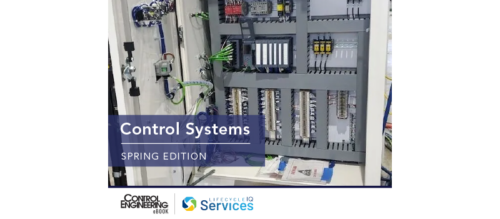Semi F47 Drives and other Components Offer Low-cost, Reliable Solutions to Voltage Disturbances
The sensitivity of manufacturing equipment and controls to voltage fluctuations in electrical systems has made power quality a major issue for semiconductor makers. Voltage interruptions cost the industry an estimated million dollars in revenue every day.
The sensitivity of manufacturing equipment and controls to voltage fluctuations in electrical systems has made power quality a major issue for semiconductor makers. Voltage interruptions cost the industry an estimated million dollars in revenue every day. Ice storms, floods, hurricanes, lightning, utility power distribution equipment failures or other system anomalies all contribute to these interruptions.
The sophisticated manufacturing requirements and minimal tolerances of semiconductor fabrication make process equipment especially vulnerable to voltage sags, which can cause equipment to shut down, resulting in loss of production. Short duration voltage dips and sags, typically lasting less than 1/4 second, are caused primarily by faults in utility electrical systems and are the dominant power-related problems faced by semiconductor fabrication facilities.
Voltage sags, also called brownouts, are reductions in the applied voltage to connected electrical equipment for a typically short duration of time. While a sag is not a complete interruption of voltage, it often causes equipment control circuits to drop out and reset — resulting in process interruption, damaged product and corresponding lost profits.
Given the costs associated with downtime and damaged product, finding ways to overcome poor power quality has become one of the industry’s most important initiatives. Through the SEMI F47 standard, established by Semiconductor Equipment Materials International, the industry is now requiring that fabrication tools maintain performance during voltage sags.The standard addresses the impact of voltage sags by requiring semiconductor tools to operate with an input AC line voltage vs. time profile. Since industry data shows that most voltage sags– between 50 and 70 percent – have a duration of less than 0.2 seconds, SEMI F47 requires fabrication equipment to sustain “without interruption” a voltage sag magnitude and duration above 50 percent for up to 0.2 seconds.
The voltage sags which SEMI F47 is designed to protect against typically occur about once per month in semiconductor fabrication facilities around the world, according to Alex McEachern of Power Standards Lab. McEachern says that industrial equipment which cannot tolerate the sags also typically fails, without explanation, about once per month. But equipment that has been designed to ride through sags experiences fewer failures and considerably more productivity.
It can take several hours to days to re-calibrate and re-qualify a fabrication line affected by even minor voltage sags and surges. Consequently, the average wafer fabrication plant suffers as much as 30 percent downtime in a typical year and significant lost production, much of it caused by voltage sags and dirty power.
The primary goal of the SEMI F47 standard is to enable process equipment and components to be able to ride through power problems and still maintain production. The SEMI F47 performance specifications are based on the Information Technology Industry Council’s CBEMA curve — a curve which is based on empirical data of typical voltage sags experienced over time.
The curve represents the power quality experience of an average fabrication house.In the past, semiconductor tool makers often used back-up battery systems or expensive power conditioning systems to protect their equipment. But batteries have a limited life, limiting the reliability of the equipment being protected. As a result, one of the primary goals of the SEMI F47 standard is to require equipment and components to be able to ride through voltage sags without relying on batteries.
Testing houses such as EPRI PEAC, an independent certifying company that has been at the forefront of testing and certification of electrical equipment since the development of the SEMI F47 standards, have found that other solutions, less costly and more reliable than power conditioners and batteries, are also better. Through compliance testing, they can identify the weak points in equipment and suggest low-cost or zero-cost solutions. These solutions range from minor changes in power supply configuration to software modifications to different relay and contactor selection.
Section 7.1 of the specification states that semiconductor processing, metrology and automated test equipment must be designed and built to conform to the voltage sag ride-through capability according to the defined curve. The primary focus of the tests are processing equipment such as etch, surface prep and clean, ion implant, metrology, photolithography, thermal, film deposition, chemical mechanical polishing tools and automated test equipment. SEMI F47 also requires suppliers to have their components certified for compliance with the sag resistance standards.
Compliance testing typically involves using a voltage source, called a sag generator, that simulates the SEMI F47 curve for a controller or other component under test. The tests include sagging the voltage on a single phase and sagging on multiple phases. Many tests are run on each component to ensure that all conditions described in the SEMI F47 standard are experienced during testing of the component and the connected load.
According to the rules set forth in the standard, all equipment tested receives a grade of pass or fail. A failure is any unplanned interruption or variance from the specifications of equipment operation other than assists. In order to pass, every component used in the semiconductor machine must meet the requirements of the standard. Failure of a single component causes the entire machine to fail.
Schneider Electric, one of the world’s leading suppliers of electrical, industrial control and automation products for microelectronics applications, has dedicated significant resources to developing sag-resistant equipment solutions that can be applied globally.
The company introduced dozens of SEMI F47-compliant products in 2002, including contactors, relays, drives and DC power supplies, all certified for compliance by EPRI PEAC.
Development work is continuing on new products as well as custom-engineered solutions for equipment-makers and fabrication plants. Schneider Electric has also introduced a number of new products to help equipment overcome voltage sags, including a low voltage ride-through module for contactors and relays and an electronic sag protector aimed at mitigating sags for complete equipment protection of critical sub-systems.
Most recently, Schneider Electric’s entire product range of Telemecanique
While the CBEMA curve was the result of testing specific to the semiconductor industry, it has serious implications for other industrial utility customers who experience similar voltage sags on their power lines. Voltage sags are serious threats to productivity and profitability in all industries where unplanned process interruptions can cause degradation or loss of product and generation of scrap. Applications in the chemical industry, prescription drug manufacturing and other sectors using temperature- and time-critical processes all suffer some degree of loss when voltage sags cause unplanned interruptions. Using SEMI F47-compliant components and equipment for any process application can mean significant financial savings for manufacturers.
For more information about Schneider Electric’s entire range of SEMI F47-compliant control and power products, visit www.squared.com .
Contact:Jeanne SchwederPriceMcNabbPhone: (704) 916-6173Fax: (704) 916-6084 jschweder@pricemcnabb.com www.SquareD.com
SEMI F47 COMPLIANT DRIVES AND OTHER COMPONENTS OFFER LOW-COST, RELIABLE SOLUTIONS TO VOLTAGE DISTURBANCES
Meeting the voltage sag immunity requirements of the semiconductor industry
Do you have experience and expertise with the topics mentioned in this content? You should consider contributing to our CFE Media editorial team and getting the recognition you and your company deserve. Click here to start this process.





